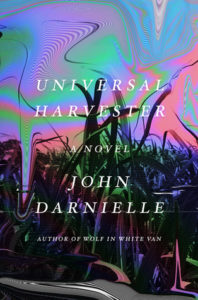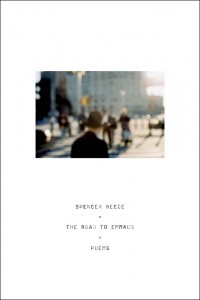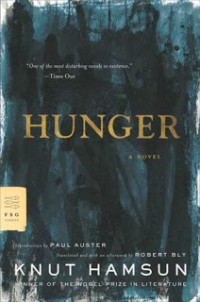25 Points: Universal Harvester
 Universal Harvester
Universal Harvester
by John Darnielle
Farrar, Straus and Giroux, 2014
224 pages / $13.21 buy from Amazon
1. I have not yet read Wolf in White Van, (but I hear good things). I also have not read (Black Sabbath’s) Master of Reality, (but I also hear good things).
2. Universal Harvester. The cover is pretty dope-looking. (Plus, it’s sorta cool that advance reader copies came in a VHS case). It totally vibes with my anodized rainbow finish razor. (That’s 2 for 2 Darnielle, tho, I am not actually counting Master of Reality).
3. But hear me out. I want to get this out of the way, like, right away: the book is marketed as horror and perhaps maybe even a little bit mystery. It’s none of these things, really. Or rather, the story isn’t horror in the way you’d expect it to be horror. And it’s also not mystery, in the classic sense of the word, mystery. It’s a little bit of both, and then some.
4. I’m not taking points away from the book either, because of this, no. It’s not Mr. Darnielle’s fault. Rather, he did this on purpose, and I applaud him (in a way) because of these things—Darnielle is trying to do something new & interesting here and, as you might expect, the average reader is not going to be so into that (I’m guessing). (Maybe the not-so-average reader, as well). The narrative is sort of non-linear (so be prepared for that).
5. I must confess, tho, to what intrigued me initially—what made me want to read the book as soon as possible—the story takes place in Iowa (I got my BA from a school in Iowa, this is no secret; and actually, the town where I went to school is mentioned, pretty early on). Also, the fact that it has something to do with VHS culture and film. (I have never seen The Poughkeepsie Tapes but the idea of VHS tapes and weird things happening on VHS tapes made me think of this film, for whatever reason).
6. I also tend to enjoy most things taking place during a time when the VHS market is / was still booming. READ MORE >
March 8th, 2017 / 6:05 pm
25 Points: Wolf in White Van
 |
Wolf in White Van
by John Darnielle
Farrar, Straus and Giroux, 2014
224 pages / $24.00 buy from Amazon
|
1. I don’t like writing. The actual act of writing, I mean. It’s hard to get started. Just getting this first of twenty-five points written took longer than the next twenty-four.
2. I like better having written, when there’s a mess of text on the page to play with. It’s not really creating anymore at that point; it’s discovery, exploring. Moving around in it and finding what I might have missed the first time.
3. John Darnielle’s Wolf in White Van is a book about a lot of things. Mostly, though, it’s about exactly this kind of discovery and exploring that appeals to me. Discovery through text, exploring between your ears. Imagined mountains, dreamt-up spaces.
4. “It gets so lonely living inside your own head,” writes the narrator, as way of explanation for having dreamt up one particularly dangerous space. The book centers on this hero’s reasons for—and the consequences of—dreaming up a game called Trace Italian.
5. Trace Italian is a by-mail role-playing game of sorts. “The way you play Trace Italian,” the narrator tells us, “seems unbearably quaint from a modern perspective, and people usually don’t believe me when I tell them it’s how I supplement my monthly insurance checks, but people underestimate just how starved everybody is for some magic pathway back into childhood.”
6. “A magic pathway back into childhood” is a better way of describing what this book is about. Memory, remembering. Finding the path back to a place where anything is possible.
7. It’s just the kind of book I like best.
8. I’m so glad this book isn’t called Trace Italian.
9. The “monthly insurance” checks the narrator mentions in point 5 above are part of the mystery of the book. What exactly happened that led this person to create a game and collect insurance checks? What caused him to live sequestered from the world? Why does he order swords from a catalog? Real, honest-to-god swords?
10. Players begin Trace Italian by sending an SASE to a PO Box and receiving in turn a sheet of paper telling them where they are in the imagined world. It’s a post-event world of sorts; they must traverse a landscape toward an end goal, the Trace, where they’ll find safety from the bad things that have taken over.
September 30th, 2014 / 2:50 pm
25 Points: The Road to Emmaus: Poems
 |
The Road to Emmaus: Poems
by Spencer Reece
Farrar, Straus and Giroux, 2014
144 pages / $24.00 buy from Amazon
|
1. I have always had a thing for men of God.
2. Spencer Reece is an Episcopalian minister. Do not let this turn you off. If you do, you will be doing yourself a great disservice. You will be denying yourself something sight unseen.
3. The priest at my father’s funeral was a radical one. His name was Father Pat, and he was a notorious IRA sympathizer. At the service, Father Pat was treated like a rock star. At his own funeral, my father was upstaged.
4. Reece did not become a minister until he was 48 years old. It took him eleven years to write the poems in The Road to Emmaus. I find this to be strangely reassuring; I always feel like I am rushing, trying to make up for lost time.
5. In 2010, Reece served at the only all-girl orphanage in Honduras, Our Little Roses, in San Pedro Sula. San Pedro Sula is the murder capital of the world. At a reading from this book that I attended last week, Reece told a story of a friend’s attempt to raise money for the orphanage from a wealthy benefactress. The woman agreed to make the donation, saying, “How else will Honduras get its maids and prostitutes?”
6. A year after my father’s death, Father Pat was arrested for laundering money for weapons to the IRA.
7. The Road to Emmaus refers to a story in the Gospel of Luke where Jesus makes an appearance to two of his disciples as they leave Jerusalem for the city of Emmaus, two days after Jesus’ crucifixion. The two disciples are leaving Jerusalem, perhaps for good, because of the events surrounding Jesus’ death. A man appears to the disciples on the road; he does not identify himself, and the disciples don’t recognize him. Instead, as he walks with them, the man corrects their misinterpretations about what has transpired; telling them it was all in line with God’s plan. Still not recognizing the man as Jesus, the disciples invite him to eat with them. Later, when they finally recognize him as Jesus, he disappears.
8. Reece describes himself as coming to religion “tentatively.” He told the Poetry Society of America that he feels a connection to T.S Eliot, who was also devout. Like Eliot, many of Reece’s poems mix verse with prose. “When I try to write, his example is never far from my mind. At times, I’d like to think I am in conversation with him,” Reece has said.
9. I have dreamed in lyrics from “Me and Julio Down by the School Yard.” And when the radical priest comes to get me released...I blame the Berrigan Brothers.
10. The story of Reece’s road to publication is oft-repeated. He wrote for over two decades, mostly alone, sometimes while living in farm house/ bird sanctuary in Minnesota, publishing only a handful of poems over that time. He sent out the manuscript for his first book of poetry, The Clerk’s Tale, to over 250 first- book contests without success. In 2003, he won the Bakeless Poetry Prize, judged that year by Poet Laureate Louise Glück. The title poem from The Clerk’s Tale was made into a short film by James Franco while Franco was a student at NYU. The poem is a story of the day in the life of Reece, and an older gay co-worker, as they go about their work day at a Brooks Brothers in the Mall of America.
September 23rd, 2014 / 1:56 pm
25 Points: Hunger
 Hunger
Hunger
by Knut Hamsun
Farrar, Straus and Giroux, 2008
272 pages / $16.00 buy from Amazon
1. This is an article about Robert Bly’s (b. 1926) translation of Hunger by Knut Hamsun (b. 1859). It was published by FSG in 1967.
2. The cover graphic is the word HUNGER stylized as an open mouth with 2 rows of sharp teeth. I bought my copy in January 2013 from a used bookseller in Toronto. The clerk said it was her favorite book, esp this edition because she liked the cover. The design is not credited in the edition notice.
3. Knut Hamsun is clean shaven and wearing a monocle in a photograph taken in 1890, the year Hunger was first published in Norway. In later photographs he is moustachioed and wears glasses. In the last known photographs of Hamsun he wears a large white beard and squints.
4. The first several times I read Hunger by Knut Hamsun was in a hardcover edition translated by George Egerton aka Mary Chavelita Dunne in 1899. This review is not about that translation, nor is it about the 1996 translation by Sverre Lyngstad.
I am descended from Norwegians but know nothing of the language. This article is not as much a review of the translation itself as it is a discussion of the fact of its publication in 1967.
5. The main introductory essay to Bly’s translation is by Isaac Bashevis Singer (b. 1902) noted Jewish-American author and pioneer of modern Yiddish literature.
“Writers who are truly original do not set out to fabricate new forms of expression,” says Singer, “or to invent themes merely for the sake of appearing new. They attain their originality through extraordinary sincerity.”
6. “People do not love alike, neither do they starve alike.” (Singer).
7. Hunger is about a young man with artistic leanings living in Kristiania, Norway. From biographical details about Hamsun we can guess that the story is based on Hamsun’s own experiences and takes place in in 1879-80.
Hunger itself does not offer much in the way of context. It is a first person account of a young man living alone in a city. He appears to have no awareness of anything outside his own need, which is mostly for food. He is starving and desperate, but the private code by which he lives forbids him from taking work that he considers to be below his abilities.
8. His mental state throughout is ostensibly a result of his being hungry, rather than a symptom of mental illness or PTSD for example. He cycles rapidly through extreme moods: hilarity, despondency, optimism, despair, loneliness, social anxiety etc.
9. Doubt is the driving force behind the narrator’s racing thoughts. His doubt tirelessly regenerates itself. Doubt is what drives the desperation and sets its parameters. It is what keeps need always at the centre.
At every moment he is like a reckless gambler who has already placed his bet before realizing the stakes are too high, and then in a panic must cut his losses before waiting to see the outcome.
“He was a man before his time,” says Singer, “His skepticism, or perhaps it could be called pyrrhonism — doubting even the doubts — belonged to a later era. To Hamsun man was nothing but a chain of moods that kept constantly changing, often without a trace of consistency.”
10. “Fictional heroes who are estranged from their environment seldom emerge lifelike,” says Singer, “With most writers, such heroes are mere shadows, or, at best, symbols. But Hamsun is able to portray both the environment and the alienation, the soil and the extirpation. His heroes have roots even though they cannot be seen.”
There is almost no historical or social/political context in Hunger. In most novels of the era that would be seen as a fault. In Hunger it is seen as a strength.
As a reader I only interact with the narrator’s environment as needed. That is because the novel is not about Norway or Europe: it is about being hungry. READ MORE >
September 19th, 2013 / 2:53 pm
